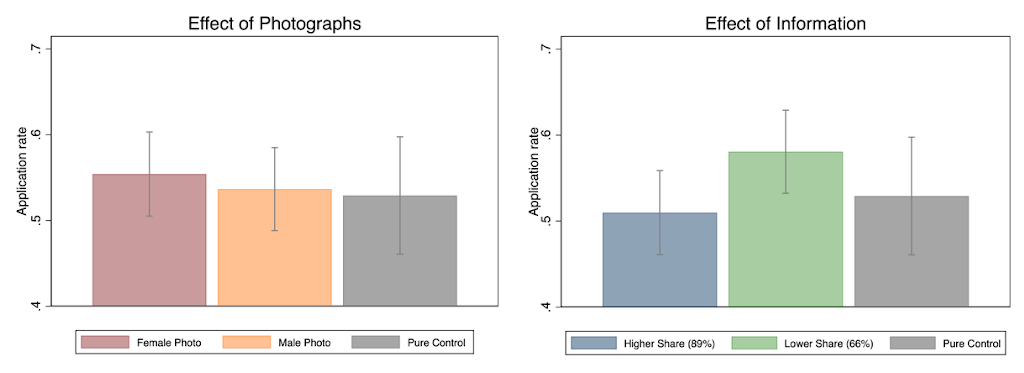ResearchEducation & Skills, Employment
Bridging the gender gap: Encouraging men into female-dominated jobs. An experiment in social work.

This is a summary of an article published in the American Economic Review by Alexia Delfino, an Assistant Professor in the Department of Economics at Bocconi University.
As traditionally male-dominated sectors like manufacturing have declined, service-oriented jobs, particularly in female-dominated fields such as social work, teaching, and nursing, have seen increased demand. But men remain underrepresented in these roles. In fact, the share of men in many of these occupations is actually declining.
In a recent study, published in the American Economic Review, I explore the barriers for men entering these so-called “pink-collar” jobs, and what can be done to lower them. Drawing on a large-scale field experiment in the UK, I show that targeted recruitment strategies can increase men’s interest in social work as a career choice. These lessons could be valuable in a wide range of similar contexts.
The bigger picture: Traditionally female jobs on the rise
In recent decades, the decline of manufacturing and the rise of service-oriented jobs have changed the landscape of labor markets across OECD countries. As traditionally male-dominated sectors have shrunk, men face greater risks of unemployment and displacement. Conversely, demand for jobs in female-dominated sectors, such as healthcare and education, has increased. However, these sectors still struggle to attract male workers, a problem that limits the potential for addressing labor shortages.
Consider social work. It is a traditionally female-dominated occupation with persistent and widespread labor shortages. Yet the share of male social workers has not changed in the past decades.
Figure 1
My research focuses on two main organizational challenges: First, how can employers increase male applications in female-dominated sectors cost-effectively? Second, how might this impact the quality of hires and the retention of both male and female employees?
Why men steer clear of female-dominated jobs
Male reluctance to enter female-dominated jobs is a complex phenomenon. The reasons likely involve a mix of job stereotypes, societal norms, gender identity, and concerns about earnings and job success. For instance, men often worry that entering a female-dominated field is not masculine. Additionally, they may doubt whether their skills and talents will be recognized and rewarded in these sectors. This hesitancy is not just a problem for men—it’s a missed opportunity for industries struggling to fill critical roles.
A fresh approach to recruitment
In collaboration with a major UK social work employer, I set out to test whether changes in recruitment strategies could encourage more men to apply for these roles. The experiment manipulated the content of recruitment messages in two important ways:
- Gender Identity: The first treatment involved including photographs of a current worker, who could be a man or a woman, in recruitment materials. The aim was to determine whether showcasing a male worker would influence men’s perceptions of social work as a suitable career, potentially reducing concerns about masculinity and gender norms.
- Expected Success: The second treatment provided information on the share of workers who received high-performance evaluations in the past. Participants were randomly informed that either 66% (“Lower success”) or 89% (“Higher success”) of workers had achieved high evaluation scores. This treatment aimed to address men’s uncertainty about their potential success in female-dominated jobs and whether their talent would be valued.
The experiment was embedded within the recruitment processes of a real organization, allowing us to study behavior under natural conditions and without direct interference from researchers. This feature also made the design portable and easy to scale.

Figure 2. a stylized example of one of the email templates used in the intervention
Information is more important than gendered photos
The findings were enlightening. It turned out that simply including photos of men in recruitment ads didn’t make a difference. Men were no more likely to apply just because they saw a male face on the flyer. This suggests that addressing deep-seated gender norms requires more than just surface-level changes.
What did make a difference was the information provided about past job performance. When men were told that a lower percentage of workers had received high-performance ratings, they were significantly more likely to apply. In fact, applications from men increased by 14% under this scenario compared to the alternative information. It seems that when men perceive a job as a challenge where their talents can make a real difference, they are more motivated to apply.

Figure 3
But the benefits didn’t stop at just getting more men through the door. Those who applied under the “lower success” scenario were not only more likely to get job offers but also performed better on the job. This approach attracted higher-quality applicants and led to better outcomes, both for the men themselves and for the employer.
Additional survey evidence suggests a key mechanism behind these results. The “lower success” information increases men’s expected premium for talent in the job. This can be in the form of better career prospects – signaling a workplace where good performance is assessed and rewarded—or the feeling that there is room for talent to improve past effectiveness in service delivery. The surveys enabled me to also test alternative interpretations of the experimental information. For instance, men may think that it is easier to get the job if fewer workers are successful, or that the daily tasks are harder. However, I do not find support for these possible other reasons.
Balancing act: Attracting men while retaining women
Interestingly, the information treatment did not affect women’s application rates. Thus, overall, this strategy was successful in bringing more and better men into social work without negative consequences on female applicants. However, while the inclusion of a male photograph in the ads did not affect male applications, it did influence potential female applicants’ behavior: it discouraged some women from applying and their retention once hired, particularly among less qualified female candidates and when combined with the “lower success” information.
My surveys reveal that the presence of a male photograph in job ads negatively impacts women’s perceptions of the desirability of social work for their gender. Female candidates exposed to a male photograph are less likely to see the job as suitable for women and more likely to believe that the employer prefers male workers. Unlike men, women also perceive the job as more difficult when the male photograph is paired with the “lower success” information, deterring lower-ability female applicants.
This raises an important consideration for employers. While it is crucial to attract more men into female-dominated jobs, it’s equally important to ensure that recruitment strategies don’t inadvertently push qualified women out. The key lies in finding a balance that encourages diversity without compromising on the quality and stability of the workforce.
So, something can be done to encourage men into social work
The insights from this study offer practical lessons for policymakers and employers alike. To attract more men to female-dominated sectors, it’s not enough to simply change the imagery in recruitment ads. What’s needed are strategies that address potential misperceptions about the job, tackling concerns that men may have about their potential success and recognition in these sectors.
Employers can take actionable steps by providing clear, realistic information about job expectations and performance standards. This can help potential applicants see these roles as viable, rewarding career paths, rather than—as the stereotype goes—low-wage “women’s work.”
At a policy level, there’s a clear case for supporting initiatives that break down gender barriers in the workforce. By encouraging men to enter female-dominated fields, we can not only address labor shortages but also promote a more diverse and inclusive labor market. As the labor market continues to evolve, it’s essential that we rethink how we attract talent to all sectors of the economy. By understanding the motivations and concerns of potential applicants, we can create more effective recruitment strategies that benefit both workers and employers alike.
Looking ahead: Directions for future research
The study suggests several avenues for future research to further understand and address gender imbalances in the workforce. One key area is exploring how different aspects of job design, beyond recruitment strategies, might influence men’s decisions to enter female-dominated fields. Additionally, investigating the long-term effects of these interventions on both male and female workers’ career progression and job satisfaction could provide a more complete picture of diversity and inclusion in these sectors. Finally, expanding the research to other industries and cultural contexts would help determine the broader applicability of these findings and refine strategies for fostering gender diversity across various industries.
Read the full article here: https://www.aeaweb.org/articles?id=10.1257/aer.20220582
If you are interested in testing further strategies to bring more men into professions like social work, teaching, health, or administration, please contact The American Institute for Boys and Men.
Subscribe to our newsletter
Get the latest developments on the trends and issues facing boys and men.
Related Research

Education & Skills, Employment
Getting men re-engaged in college
Men are 42% of students but 51% of stopouts. Why men leave college and how re-enrollment programs can bring them back.

Education & Skills, Employment
Occupations by gender: The facts
America’s workforce is evolving — gender roles are shifting, industries are transforming, and data reveals what's really driving change.

Education & Skills, Employment
How “gifted education” can be a game changer for disadvantaged boys
Gifted programs boost college entry for low-income boys—a 28-point jump for those just over the IQ threshold.